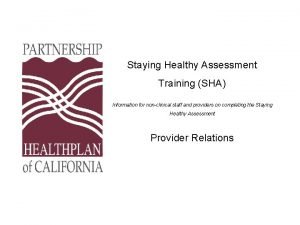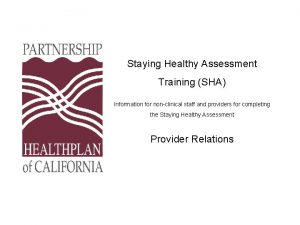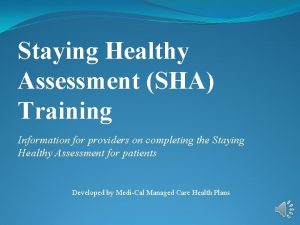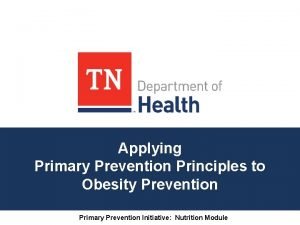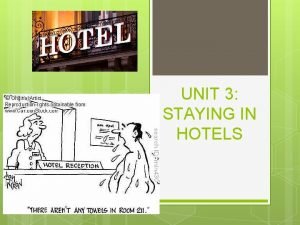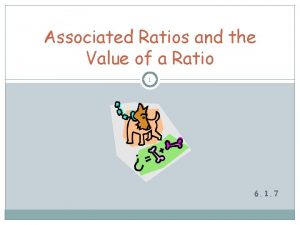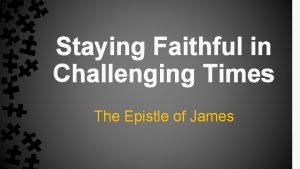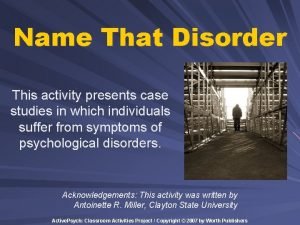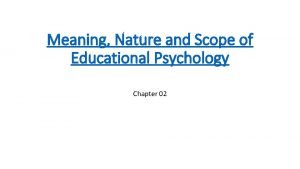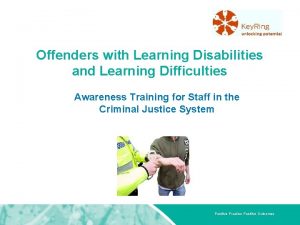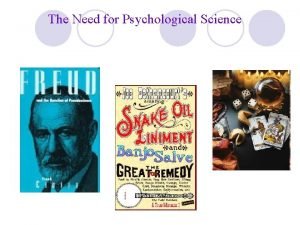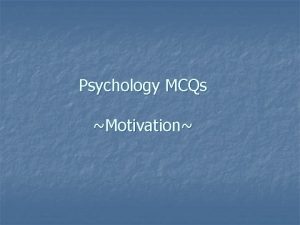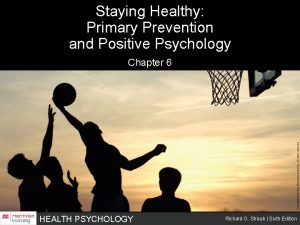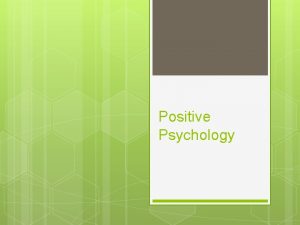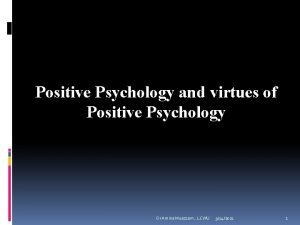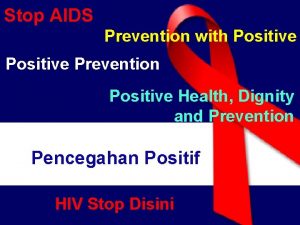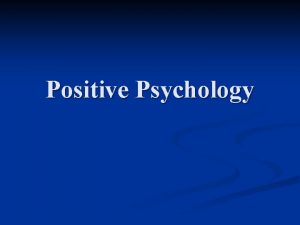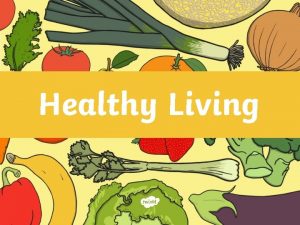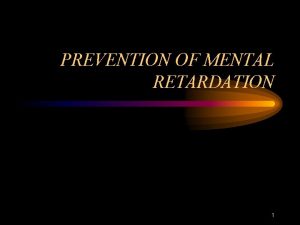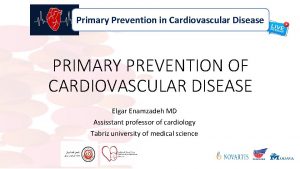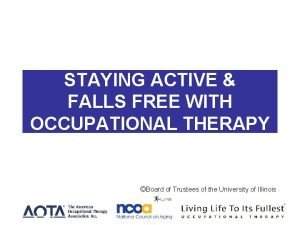Staying Healthy Primary Prevention and Positive Psychology Chapter




































- Slides: 36

Staying Healthy: Primary Prevention and Positive Psychology Chapter 6 HEALTH PSYCHOLOGY Richard O. Straub | Sixth Edition

Health and Behavior • Health Behaviors • Include health-enhancing behavior or habit • Occur on a continuum; both positive and negative health impact • May have long-term and short-term and interactive effects • Health Habits • Are firmly established and automatically performed health behaviors

Youth Risk Behavior Surveillance System (YRBSS) • Health-Risk Behaviors • • • Smoking and other forms of tobacco use Unhealthy dietary behaviors Inadequate physical activity Alcohol or other drug use Sexual behaviors related to unintended pregnancy and STDs Behaviors that contribute to unintentional injuries and violence

Theories of Health Behavior • Health psychologists have developed a number of theories to explain why people do or do not engage in healthful or unhealthful behaviors • Influential Theories • • Health Belief Model (HBM) Theory of Planned Behavior (TPB) Transtheoretical Model (TTM) Health Action Process Approach (HAPA)

Health Belief Model (HBM) (part 1) • Decisions about health behavior are based on four interacting factors that influence perceptions about health threat • • Perceived susceptibility Perceived severity of health threat Perceived benefits of and barriers to treatment Cues to action

Health Belief Model (HBM) (part 2)

Health Belief Model (HBM) (part 3) • A commonsense theory proposing that people take action to ward off or control illness-inducing conditions if: • They regard themselves as susceptible • They believe the condition has serious personal consequences • They perceive that the course of action will reduce either their susceptibility or the severity of the condition • They believe that the benefits of the action outweigh the costs • Environmental influences are encouraging change

Health Belief Model (HBM) (part 4) • The HBM has been subjected to extensive research • Intervention effects • Focus on perceived risk versus emotional responses • Protection Motivation Theory (PMT) adds self-efficacy

Theory of Planned Behavior (TPB) (part 1) • Specifies relationships among attitudes and behaviors • Suggests measuring behavioral intention is the best way to predict occurrence of health behavior • Is most accurate in predicting goal-oriented, rational behaviors • Factors Shaping Behavioral Intentions • Attitude toward behavior • Subjective norm • Perceived behavioral control

Theory of Planned Behavior (TPB) (part 2)

Transtheoretical Model (TTM) (part 1) • Proposes that people pass through five, nonlinear stages in altering health behavior • • • Stage 1: Precontemplation Stage 2: Contemplation Stage 3: Preparation Stage 4: Action Stage 5: Maintenance

Transtheoretical Model (TTM) (part 2)

Health Action Process Approach (HAPA) • Specifies Two Stages • Motivational phase (goal-setting) • Volitional phase (goal-pursuit) • Growing body of research supports the fundamental principles of HAPA, especially the importance of planning in promoting successful behavior change

Prevention • Three types of intervention undertaken before, during, and after a disease strikes • Primary prevention • Secondary prevention • Tertiary prevention • See Table 6. 1 in the text to learn more about levels and timing of prevention for HIV/AIDS

Compressing Morbidity • Health psychologists work to shorten the time people spend in morbidity • Is healthy living a magic bullet?

Promoting Healthy Families and Communities (part 1) • Preventive health psychology research has increased focus on external systems that influence individual health • Family behaviors • Health system factors • Community influences

Promoting Healthy Families and Communities (part 2) • Family Behaviors • Health habits are often acquired from parents, siblings, and others who model health behaviors • Establishing good health habits before adolescence is important • Certain family characteristics create a cascade of risk • Overt family conflict • Deficient nurturing • Failure to establish good health habits may increase health risks throughout life

Promoting Healthy Families and Communities (part 3) • Health System Factors • Medicine tends to focus on treatment rather than prevention; early warning signs go undetected • Unsuccessful implementation of ACA means number of Americans without health insurance could reach 54 million by 2019; successful implementation may increase insurance premiums (HDHPs) • Economic forces undermine health care workers’ efforts to promote preventive measures

Interpreting Data • Which Americans Are Uninsured?

Promoting Healthy Families and Communities (part 4) • Community Influences • People are more likely to adopt health-enhancing behaviors that are promoted by community organization • Some environments promote health-compromising behavior; others can exert powerful negative influence • Most peer-inspired, health-related risk-taking is short-lived before irreversible, long-term consequences arise

Community Health Education (part 1) • Substantial effort devoted to shaping the public’s views on health issues • Through educational campaigns in advertisements, on public transportation, in magazines and newspapers, and on television, radio, and Web sites • Example: Promotores de salud • OMH initiative/ACA estimates that 9 million Latinos have/will have health insurance • Promotores provide education in culturally competent and linguistically appropriate way

Community Health Education (part 2) • Health education includes any planned intervention involving communication that promotes the learning of healthier behavior • Precede/Proceed Model • Identifies specific health problems in a community • Identifies lifestyle and environment elements that contribute to the targeted behavior • Analyzes background factors that predispose, enable, and reinforce these lifestyle and environment elements • Implements a well-designed health education program

How Effective Are Health Education Campaigns? • Campaigns that merely inform people of the hazards of certain behaviors (e. g. , antismoking messages) are typically ineffective • Multifaceted campaigns that present information on several fronts are generally more effective than “single-shot” campaigns

Message Framing • Health messages generally are framed in terms of the benefits associated with a particular preventive action or the costs of failing to take preventive action • Gain-Framed Message • Effective in prevention behavior promotion • Loss-Framed Message • Effective in illness-detection promotion • Tailored Message

Cognitive-Behavioral Interventions • Focus on conditions that elicit health behaviors and factors that help to maintain and reinforce them • • • Self-monitoring Operant conditioning Discriminative stimuli Stimulus-control interventions Relapse prevention Contingency contracting

Promoting Healthy Workplaces (part 1) • Occupational Health Psychologists • Dimensions of Healthy Work • • Stress Work–family relations Violence prevention Relationships at work • Behavioral Crossover Effects • Negative emotion spillover • Social withdrawal

Promoting Healthy Workplaces (part 2) • Over the past 20 years, significant shift in the perception of work–family life relationship • Recognition of complex family–work balance faced by all employees • Lack of support or input into work policies • Increase in workplace and campus violence • Building a healthy work culture requires attention to three factors • Person • Environment • Behavior

Women’s Labor Force Participation Rate, 1950– 2015 and Projected to 2024

Promoting Healthy Workplaces (part 3) • Work-Site Wellness Programs • Ideal for promoting health because of convenience for workers, opportunities for social support, follow-through and feedback • Preventing disease is easier, cheaper, and far more desirable than curing disease • Cost of the programs is more than offset by reductions in work-related injuries, absenteeism, and worker turnover

Percentage of Employers Offering Various Types of Health Promotion Programs

Positive Psychology and Thriving • Positive psychology is the study of optimal human functioning and the healthy interplay between people and their environments • Included in APA mission statement in 2001 • Strength-based, preventive approach • Adversity can sometimes yield benefits • Thriving is a paradoxical outcome in which adversity somehow leads people to greater psychological and/or physical well-being

Allostasis and Neuroendocrine Health • When the brain perceives an impending threat or challenge, anabolic metabolism is converted into its opposite, catabolism, that breaks down tissues to be converted to energy • Anabolic metabolism counters arousal and promotes relaxation, energy storage, and healing processes • Physical thriving • Allostatic overload

Neurobiology of Resilience (part 1) • Resilience is the capacity of the brain and body to withstand challenges to homeostasis. • Dysregulation and allostatic overload • Early life resilience mediated by distinct biological adaptations (e. g. , neuroendocrine) • Biological embedding shaped by neuroendocrine system feedback

Neurobiology of Resilience (part 2)

Psychosocial Factors and Physiological Thriving • Psychosocial factors linked to beneficial effects on immune functioning and other bodily systems • • • Self-enhancement Social integration Relaxation Spirituality Curiosity Perceived control and self-efficacy

Beyond Positive Psychology • Critics of positive psychology • Not enough attention paid to the interpersonal context in which individual traits are displayed • When social context is considered, some studies posit that psychological traits are not inherently positive or negative, but depend on the context in which they operate
 Primary prevention secondary prevention tertiary prevention
Primary prevention secondary prevention tertiary prevention Staying healthy assessment
Staying healthy assessment Not to smoke sentence about staying healthy
Not to smoke sentence about staying healthy Sha questionnaire
Sha questionnaire Staying healthy assessment form
Staying healthy assessment form Positive psychology ap psychology definition
Positive psychology ap psychology definition Nutrition and productivity
Nutrition and productivity Healthy soil healthy life poster ideas
Healthy soil healthy life poster ideas Healthy community poster
Healthy community poster Healthy nurse healthy nation
Healthy nurse healthy nation Stay healthy unit 3
Stay healthy unit 3 Principal of health education
Principal of health education Primary prevention of obesity
Primary prevention of obesity Site:slidetodoc.com
Site:slidetodoc.com Mark brittain staying fat for sarah byrnes
Mark brittain staying fat for sarah byrnes Unit 3 staying in hotels
Unit 3 staying in hotels Associated ratios
Associated ratios The behavioral-change stairway begins with staying on track
The behavioral-change stairway begins with staying on track I had ____ fish and ____ chips for dinner
I had ____ fish and ____ chips for dinner Remaining faithful in hard times
Remaining faithful in hard times Sadie is so fearful of being overwhelmed
Sadie is so fearful of being overwhelmed Odd man out stv xya kkt bde
Odd man out stv xya kkt bde On leaving on staying behind analysis
On leaving on staying behind analysis Deindividuation
Deindividuation Scope of education psychology
Scope of education psychology Staphylococcus epidermidis en agar sangre
Staphylococcus epidermidis en agar sangre Positive + positive equals
Positive + positive equals Positive practice positive outcomes
Positive practice positive outcomes Puncture resistant container
Puncture resistant container Chapter 26 infectious disease prevention and control
Chapter 26 infectious disease prevention and control Chapter 19 disease transmission and infection prevention
Chapter 19 disease transmission and infection prevention Chapter 19 disease transmission and infection prevention
Chapter 19 disease transmission and infection prevention Chapter 16 infection control and standard precautions
Chapter 16 infection control and standard precautions Examples of naturalistic observation
Examples of naturalistic observation Positive psychology mcqs
Positive psychology mcqs Computer metaphor psychology
Computer metaphor psychology Concepts of positive psychology
Concepts of positive psychology

